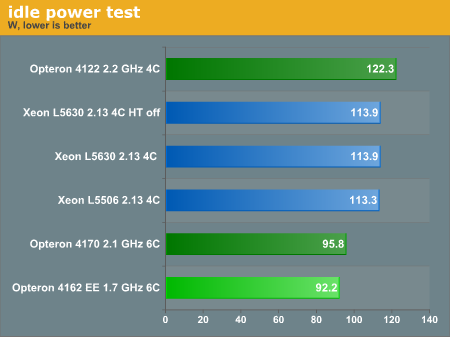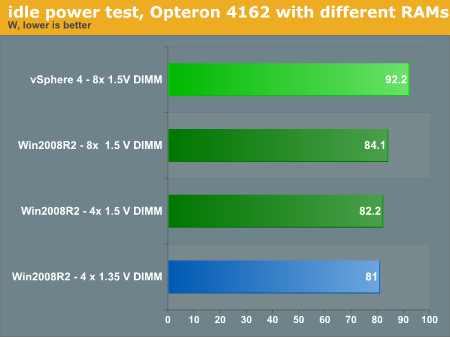Balancing Power, Price, and Performance in the Server CPU World
by Johan De Gelas on March 3, 2011 7:07 PM EST- Posted in
- IT Computing
- AMD
- Intel
- 1000W
- Xeon
- Opteron
- Cloud Computing
Idle Power Use
According to AMD, the key market for the low power "Lisbon" Opteron EE and HE is the cloud and web hosting space, where achieving the lowest power consumption possible is priority number one. So we measured the idle power draw running vSphere 4.1. The power policy selected was "Balanced".

Before we start analyzing the numbers, we must say that the Intel platform can probably go lower. It is possible to use a 450W PSU in this server, but we only had the 650W version available. This is an 80 Plus Silver certified PSU, so it should be at least 75% efficient at 10% load and 85% efficient at 20% load, and we're at around 15% load for this test. Although the idle numbers might be somewhat high for the Intel platform, our real-world power numbers on the next page shouldn't be off by more than a few watts, and those real-world numbers are the ones that count.
The AMD system came equipped with 16GB of low power DIMMs, but we did not use them for this test. The reason is that our vApusMark II takes 14GB per tile, and our standard test for dual socket systems is to use two tiles. Those two tiles need at least 28GB of RAM, plus some space for the ESX console and hypervisor (0.3 to 0.8 G RAM for the console + 0.5GB to 1GB for the vmkernel). We can show you what effect these low power DIMMs have at idle:

Even at idle, a hypervisor has more work to do than a supervisor OS like Windows 2008 R2. The result is a 10% higher power draw at idle. Each regular 1.5V DDR3 DIMM seems to take 0.5W at idle (2 Watt/4). If you replace four regular DDR3 DIMMs with four low power DIMMs at 1.35V, you can cut the RAM power draw in half. Low power DIMMs seem to save 0.3W per DIMM (1.2W / 4) at idle. So all in all, the RAM subsystems seems to draw little power at idle.
When the SQL server 2008 was running at 90% CPU load we measured a difference of 4.9W between four low power and 1.5V DDR-3 DIMMs. So low power DIMMs save you about 1.25W per 4 GB DIMM.










35 Comments
View All Comments
qrazi - Friday, March 4, 2011 - link
Don't forget that a higher TDP also requires a higher capacity cooling and PSU, which in turn also means higher power requirements.And if it's not the only server in the rack, thermal output can be a real issue.
7Enigma - Friday, March 4, 2011 - link
Exactly. This point is missed in almost all articles related to power consumption. "But it's only 5 cents per week more...blah....blah....blah".Yes but the problem is the cost associated with the REMOVAL of that heat that is often much more expensive and troublesome than the actual moderate increase in power consumption. This is compounded in a server environment where even a slight increase can start to cause issues with air handlers, total power draw for the room, and that extra 5 cents can become a significant increase in operating costs.
So please before someone else writes a post in this or an upcoming article think the whole situation through. It's not just the additional power the server uses, but what do you do with that extra power (in the form of heat) that really matters.
ZL1Corvette - Friday, March 4, 2011 - link
PSU: I understand that when custom building a server you'll get to match you exact load to your PSU. How about when you're buying a premade though. I don't buy servers but I bet Dell charges a fine premium when you upgrade to the higher dollar CPU. Quick trip to Dell page says the 4170HE is a $102 premium over the 4122. That price makes it look like they keep the same PSU installed. Going with a 4162EE costs $252, which still looks like they're keeping the same PSU. The 35W chip saves you $52 a year. 5 year pay back until you consider heat removal.Heat: CPU's make heat through electrical resistance, which is actually a pretty inefficient way to make heat. Your AC system is better, but we'll assume it's equal. You can take all of my original pay back numbers and cut them in half. That means almost all of these chips take from 1.5 to 2.5 years to pay for themselves.
How long do you keep a server? I'm sure I have no idea, but most companies don't implement a cost saving unless it pays back in under two years.
You're right, there are extra costs, some of the time. What about the quarter of the year when it's cold outside? How about when you already have the system and are considering upgrading just for the lower operating costs? Too many times I've seen forum posts about people "saving" all this money by reducing their computer power draw by a few watts.
JohanAnandtech - Saturday, March 5, 2011 - link
Quite a few people have given you already a good answer. Check also the "Power cost" by ERJ post out. Most people collocating will pay a fixed cost, and will pay a lot more if they create "bursty power" (i.e. demand more power than was agreed). So requiring a half Amp less or more than your limit can make a big difference.bwj - Friday, March 4, 2011 - link
Why do you think least power consumption is important for cloud providers? A cloud provider wants to keep all servers running at peak utilization, all day, every day of the week. The platform is at 80% of its peak power consumption when 10% loaded, so there's little cost going from 10% to 100% load. A cloud provider wants the highest throughput per watt at 100% load.duploxxx - Friday, March 4, 2011 - link
Why would you choose in this configurations for a balanced power schema? doesn't make sense to me and it is very OEM depending weather those power schema work well or not, certainly on Vmware.Next time select also LP dimm's although retail might show a price difference, it's no longer the case when you have a decent price reduction from server volume.
vAPU 2 is a great benchtool but the score i still a bit flawed because of the WEB bench results. You miss a 9th or 10th that would serve files orso.
silverblue - Friday, March 4, 2011 - link
HAHA McAfee makes things more secure?Thank you for brightening up my Friday.
tech6 - Friday, March 4, 2011 - link
A test of Watts per unit of work done would have interesting.duploxxx - Friday, March 4, 2011 - link
People like you should be banned from the internet, your personal feelings towards a certain vendor clearly affect your way of working with IT.I pity those who would do any business with you with such a narrow mind. By folks like you we would still be living in the Netburst ERA, wasting hours of time waiting for a job to finish.
Just FYI in the 2p server compare here there is not a single RAS feature intel has more then AMD, and using the platform you obviously refer too (EX) in a power consumption compare would be a really big joke, just like the more secure intel cpu thx to mcafee hence they just bought the company not let alone integrating this before 2013.....
Bugs, yeah right, you mean bugs from the one behind the keyboard. we use 1000's of Intel and AMD servers in Hospital environments, both do there jobs more then well.
Intel is not a standard, x86 is which is btw not created by Intel, not to mention the 64bit you are probably running these days :D
duploxxx - Friday, March 4, 2011 - link
are you really that stupid? we are talking here about server platform. Intel 55xx and 56xx series are connected through Tylersburg chipset, perhaps start reading a bit more.http://www.avadirect.com/intel-nehalem-ep/intel-ty...
thx for the information sharing but I have a feeling that there will be many other people with more added value posts ....
Your smooth, lightning fast ATOM system seems to be handling the CUT/PASTE typing really well ......